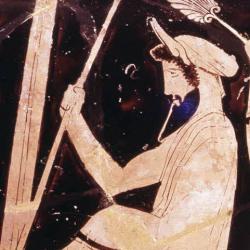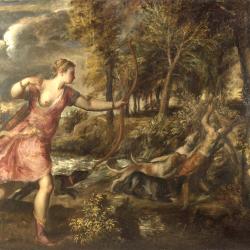You are here
Week 2
The theme for this week’s stories is Punishment and the history topic is Greek theatre. In the lead story, King Midas 2, Apollo punishes King Midas for saying what he thinks by giving him the ears of an ass. In the second story, Aktaion is turned into a stag by Artemis when, by chance, he catches sight of her naked.
History materials
- Main topic
- Key ideas
- Making the link
- Teaching the topic
Greek theatre
Simple examples of the continuing influence of Greek theatre can be identified in the traditional classification of plays into tragedies and comedies, the use of tragic and comic theatre masks to symbolise the whole concept of acting, and the layout of many theatres.
While the idea of acting out stories as part of religious ritual did not originate with the Greeks, the performance of scripted plays with relevance outside the purely ritual seems to be a distinctively Greek contribution to the history of theatre. The status of ancient Greece in western culture has made Greek theatre a standard to be respected, emulated or challenged by both western and non-western dramatists.
Competition
The competitive nature of Greek culture showed itself not just in the areas of politics and warfare, but also through contests in athletics, music and singing, and theatre. Competition in areas which we now consider to be entertainment or leisure was regarded as an appropriate way of honouring the gods.
Festivals
Festivals in honour of gods were an important way of developing a sense of group identity. Most festivals were focused on the community of the individual city state, for example the drama festivals in Athens. Some, for example the Olympic Games, drew on a wider community, being open to participation by anyone who was a Greek.
There are two main links from the story into the topic of theatre and you might want to take them in order: 1) the musical instruments played by Pan and Apollo and 2) the contest the two gods take part in.
The instruments
Why not start with what the children learn from the story? The storyteller refers to the instruments as ‘Pan pipes’ and a ‘lyre’. You could begin by asking the children what they can tell about these, with the aim of identifying the pipes as a wind instrument and the lyre as a stringed instrument. Look at these pictures of Apollo and Pan to confirm the children’s ideas. You could ask what they think the instruments were made of.
This statue shows Pan teaching a young man how to play the pipes. Notice his goat legs and head.
This scene from the inside of a wine cup shows Apollo seated on a stool, pouring an offering of wine from a bowl. It is easy to see that the sounding box of his lyre was made from a tortoise shell. This cup was found at Delphi in Greece, which was the site of one of the most important sanctuaries to Apollo. The bird may be linked to Apollo’s role as a god of prophecy.
The next step might be to look at these two examples of the two instruments. Use these and the statue and painting to discuss how the two instruments were played; do the children think that one type was more sophisticated than the other?
A set of nineteenth century pan-pipes from Papua New Guinea; British Museum object number Oc.9194.
A reconstructed lyre; British Museum object 1816,0610.501
Contests
The idea of a music contest should be familiar to most of the children through reality TV shows. You could use the Greek festivals sheet below to establish that music competitions were important parts of festivals in honour of gods rather than being purely for entertainment or leisure. What do the children think of this? What reasons might there be?
Greek festivals information sheet:
Information for children about Greek festivals with a simple map of Greece showing the locations of important festivals that included athletic contests: Olympia (Olympic Games for Zeus), Delphi (Pythian Games for Apollo), Corinth (Isthmian Games for Poseidon), Nemea (Nemean Games for Zeus), Athens (Panathenaic Games for Athena).
You might like to make the connection between the musical contest in the story and the drama contests that took place in Athens in festivals to Dionysos.
Dionysos and the theatre
A good place to start the transition to theatre would be to look again at the cup painting of Dionysos and satyrs in the resources for King Midas 1. Identify the castanets held by the satyrs, the lyre held by Dionysos and his head thrown back as he sings. Why not discuss how music can make you feel different emotions, and connect this with the excitement shown by Dionysos’ followers? Either here or later, you could discuss why theatre is an appropriate form of activity in honour for this god — you could draw an analogy between Dionysos’ power to change people through wine and music and the idea of one person taking on another person’s character and actions through acting and wearing a mask.
Theatre
This excellent weblink provides accessible information for teachers about Greek theatre, images and resources, weblinks and ideas for teaching activities.
Greek theatre activities bank:
You could use the Theatre festivals sheet below to make the transition from music and singing contests to the idea of stories being sung and then acted in plays. The chorus remained an important feature of Greek theatre throughout much of its history. The circular area of the theatre set aside for the chorus was called the ‘orchestra’, which means ‘the dancing place’.
Theatre festivals information sheet:
Information for children about theatre festivals with a modern illustration of an early theatre performance with just one actor and a chorus. Members of the satyr chorus are dancing and playing the aulos. The one male actor carries a basket of masks to enable him to change character as he tells and acts out a mythical story.
The pot that features in the next two weblinks provides important evidence for costume and masks:
This detail from a pot shows two actors dressed in their costumes and holding masks. The figure on the left will be playing Herakles as we can see from his club. The figure on the right, with his tufty body stocking, will be playing Silenos, Dionysos’ companion in King Midas 1.
Pot showing the cast of a play:
You can see the whole of the above pot here, with other actors and chorus, aulos and lyre players and a satyr chorus member dancing.
You could follow up by using this Theatre performance sheet to identify details of performance and the theatre:
Theatre performance image sheet:
A modern illustration of a performance of a scene from the play Agamemnon, by the Athenian playwright Aeschylus. It gives children the chance to explore and identify details. In the play, King Agamemnon returns home from the Trojan War. He is then murdered by his wife Klytemnaistra in revenge for his sacrifice of their daughter in order to gain a fair wind to sail to Troy.
The children could label the drawing: two actors (both men wearing masks), twelve members of the chorus (all men wearing masks), the altar to Dionysos in the centre of the theatre, the low stage, the open-air theatre, the audience, the steps up to the back rows, seating sections with Greek letters. If the children don’t notice it themselves, you could draw their attention to the musician playing the aulos.
Work on the layout of a Greek theatre might come before looking at the picture or might arise from it, with a reconsideration of the picture once the children have learned more.
You might like to do an initial exploration of this pot painting of a comedy performance to see what it tells us about the theatre, masks and costumes. Use the action shown to bring out the knockabout humour of such a scene. The children could have a go at acting it to see how they can make it as funny as possible.
This lively scene from a pot shows an old man, probably drunk, who is being pushed on to the stage by his slaves. It is useful to show the stage building and masks and communicates the humour of the scene.
Other musical instruments
Depending on time, you could look at other instruments, especially the double-flute or aulos. Use the image links below to find examples of other ways of making music, for example, different sorts of lyre, straight trumpets and the double-pipes or auloi. As children identify the instruments, see if they are being used by particular types of people and in particular situations. The aulos and lyre were played in competitions and at drinking parties, called symposia, where performers and participants might sing and dance. The trumpet was limited mainly to use in battle, where the aulos was also used. Dancers played castanets and drums.
Scroll across to the ‘rolled-out’ view of this cosmetics pot in the Museum of Fine Arts, Boston. It shows three different lyres, pan pipes and an aulos being played. It is thought that the seated man with the lyre is a famous poet — he is holding his plectrum in his right hand. The women surrounding him are probably the Muses, goddesses of music and the arts.
An aulos made of wood. Although commonly called a double flute, the aulos was more like an oboe as it had a reed in the mouthpiece. British Museum object number 1816,0610.502.
A vase-painting showing a Greek warrior blowing a trumpet; British Museum object number 1849,0620.1.
A vase-painting showing a dancer with castanets — compare the satyrs with Dionysos — and a young musician playing the aulos; British Museum object number 1843,1103.9.
A vase-painting from a wine cup showing a drinking party with a lyre player and a woman playing the aulos; British Museum object number 1848,0619.7
The reconstruction of the sound of ancient Greek music is very complicated and the subject of intense discussions among scholars. In this video, an Austrian scholar plays the aulos.
The sounds of an aulos and a lyre:
This weblink is to some examples based on research by the same scholar and includes examples of music played on the aulos and the cithara (lyre). The two invocations are good short examples of lyre playing.
This weblink provides a useful article for teachers by a British scholar about the reconstruction of music and an example of a short song to play to children.
Continuing theme: gods and goddesses
If you have started one, add entries for Pan and Apollo to your list of gods and include what the children have learned about them so far from the story. Add any further information they have learned about Dionysos, for example, his connection with theatre and transformation.
By the end of this week, if you have studied both stories, the children will have encountered the following additional gods and divine beings:
Pan
Apollo
Artemis — conveniently the sister of Apollo in King Midas 2
nymphs

